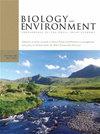INTRODUCTORY REMARKS II
IF 0.6
4区 环境科学与生态学
Q4 ENVIRONMENTAL SCIENCES
Biology and Environment-Proceedings of the Royal Irish Academy
Pub Date : 2022-01-01
DOI:10.3318/BIOE.2005.105.3.127
引用次数: 0
Abstract
Ireland is one biogeographical entity. The main responsibility for conservation in Northern Ireland lies with the Environment and Heritage Service (EHS). This is an executive agency functioning within a government depart ment, the Department of the Environment. The EHS is a broadly based body and its functions are very varied. As well as conserving nature, its functions range from protecting the physical environment against pollution, to conserving ancient monuments and historic buildings, to the building of awareness of environmental issues in the community at large. We are also responsible for various aspects of access to the countryside and of conserving landscapes. Much of our activity in biological conservation is now determined by the Northern Ireland Biodiversity Strategy, published in 2002. The strategy is included under the umbrella of the UK Biodiversity Action Plan, but it is explicitly and closely tailored to the requirements of biodiversity in Northern Ireland over the next fifteen years. The Strategy as a whole includes broad measures to address conservation in such policy fields as agriculture, forestry, fishing, tourism, construction and education. Another important aspect of the Strategy is the specific measures to address the needs of habitats and species under threat. Our priorities for action in this area recognise our position as part of Europe. Indeed the demands of the Birds and Habitats directives originating from Brussels would not let us do otherwise.导言ii
爱尔兰是一个生物地理实体。北爱尔兰的保护工作主要由环境和遗产局负责。这是一个执行机构,隶属于一个政府部门,即环境部。EHS是一个基础广泛的机构,其职能非常多样化。除了保育自然外,它的功能包括保护自然环境不受污染、保育古迹和历史建筑,以及培养社会大众的环保意识。我们还负责通往乡村和保护景观的各个方面。我们在生物保护方面的大部分活动现在都是由2002年出版的《北爱尔兰生物多样性战略》决定的。该战略被纳入《联合王国生物多样性行动计划》,但它明确和密切地针对北爱尔兰未来15年生物多样性的要求进行了调整。整个战略包括在农业、林业、渔业、旅游、建筑和教育等政策领域处理养护问题的广泛措施。《战略》的另一个重要方面是采取具体措施,满足生境和受威胁物种的需要。我们在这一领域的行动重点是承认我们作为欧洲一部分的地位。事实上,来自布鲁塞尔的《鸟类和栖息地指令》的要求不允许我们这样做。
本文章由计算机程序翻译,如有差异,请以英文原文为准。
求助全文
约1分钟内获得全文
求助全文
来源期刊
CiteScore
1.10
自引率
0.00%
发文量
6
审稿时长
>36 weeks
期刊介绍:
The journal aims to offer a broad coverage of the subject area, including the following:
- biology and ecology of the Irish flora and fauna
- microbial ecology
- animal, plant and environmental physiology
- global change
- palaeoecology and palaeoclimatology
- population biology; conservation of genetic resources
- pollution and environmental quality; ecotoxicology
- environmental management
- hydrology
- land use, agriculture, soils and environment.
Submissions on other relevant topics are also welcome, and papers of a cross-disciplinary nature are particularly encouraged.

 求助内容:
求助内容: 应助结果提醒方式:
应助结果提醒方式:


